Menu
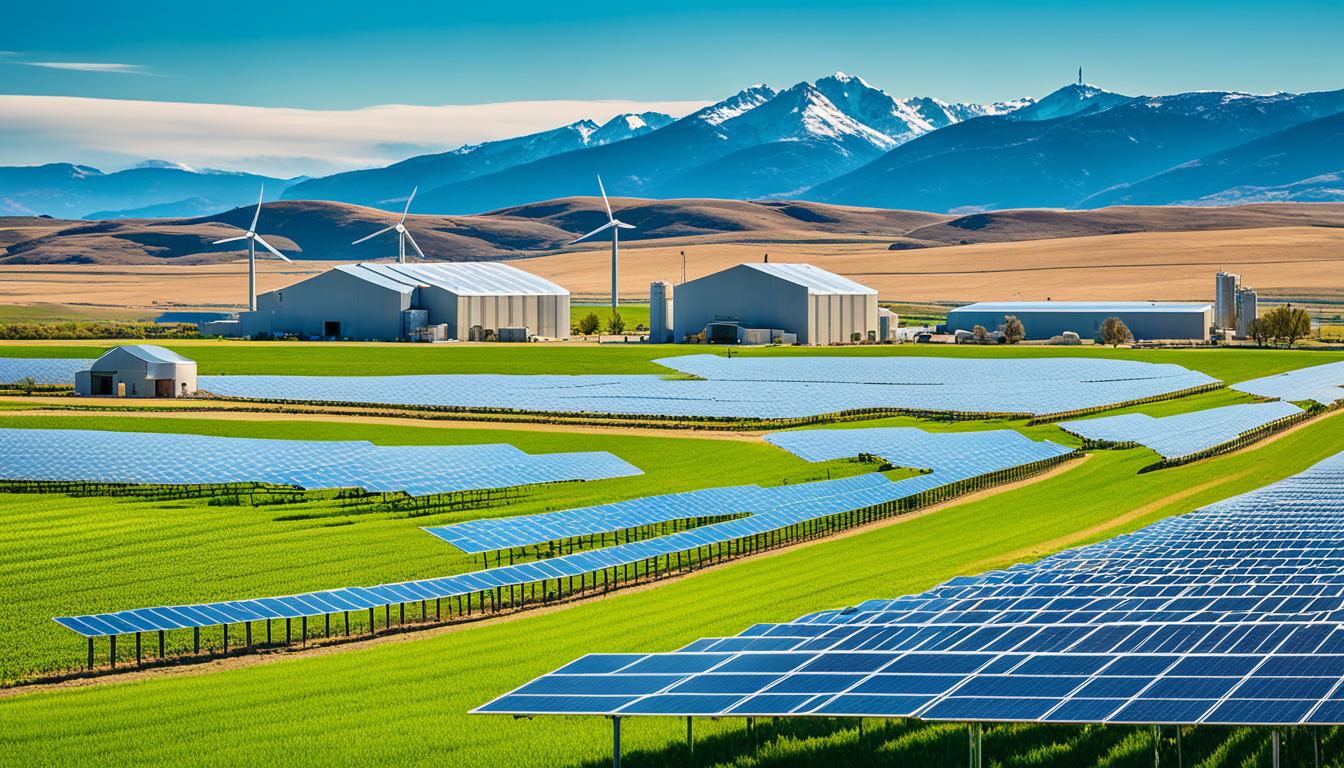
Farmers, like Roger Rainville, are making biodiesel for less than $2 per gallon. This shows that using renewable energy in farming is not just good for the planet. It’s also smart for saving money and making more profit as fuel prices go up.
Agriculturalists all over are turning to solar power, wind power, and more. By doing this, they cut costs and earn extra money in the long run. Solar panels warm up water, buildings, and barns. Wind turbines give power for different jobs on the farm.
Plants like camelina, canola, and sunflowers are becoming new energy sources. They grow quick, which is great for our environment. Wind energy is growing fast around the world too. This shows farming is heading towards a more sustainable future.
By 2050, our world will almost reach ten billion people. This growth means we need to produce 70% more food. More than one billion folks rely on farming for their living. So, sustainable agriculture is key. It helps keep our planet and our finances healthy. By using eco-friendly farming, we can enjoy many benefits in all areas of life.
Sustainable agriculture aims to produce food without harming the planet. It uses less water, natural fertilisers, and keeps the soil healthy. This saves our natural resources for the future. Working without fossil fuels and protecting a variety of plants and animals creates a better balance in nature. Using clean, renewable energy and fewer pesticides makes our food system stronger and more efficient.
Sustainable farming is also good for business. It lowers costs and brings in steady money for farmers. This is especially good for small farmers and their local communities. As a bonus, it can produce more food that’s better for us. This means we all get to eat well at a fair price. So, sustainable practices make both the earth and our wallets happy.
| Aspect | Benefit |
|---|---|
| Environmental | Reduced water usage, Natural fertilisers, Soil preservation |
| Economic | Lower operational costs, Stable income, Higher yields |
| Social | Green jobs, Healthier food, Strengthened communities |
Sustainable farming does wonders for people. It brings new jobs and fresher food to rural areas. This makes communities stronger and more fair. It also boosts local economies. Choosing to farm in eco ways supports new eating habits like veganism. This is great for our planet and makes us less reliant on old farming methods. So, sustainable agriculture is a real win for everyone, keeping food secure and life good.
For more insights, you may visit The Importance of Sustainable Agriculture.
Today, using renewable energy is crucial for farms. It helps our planet and saves money. Solar power, wind energy, and biofuels are key eco-friendly energy sources for farmers.
Farms harness solar power using photovoltaic panels. These reduce electric bills and keep energy clean. This green energy heats water, buildings, and operates farm machinery. It improves farming efficiency and sustainability.
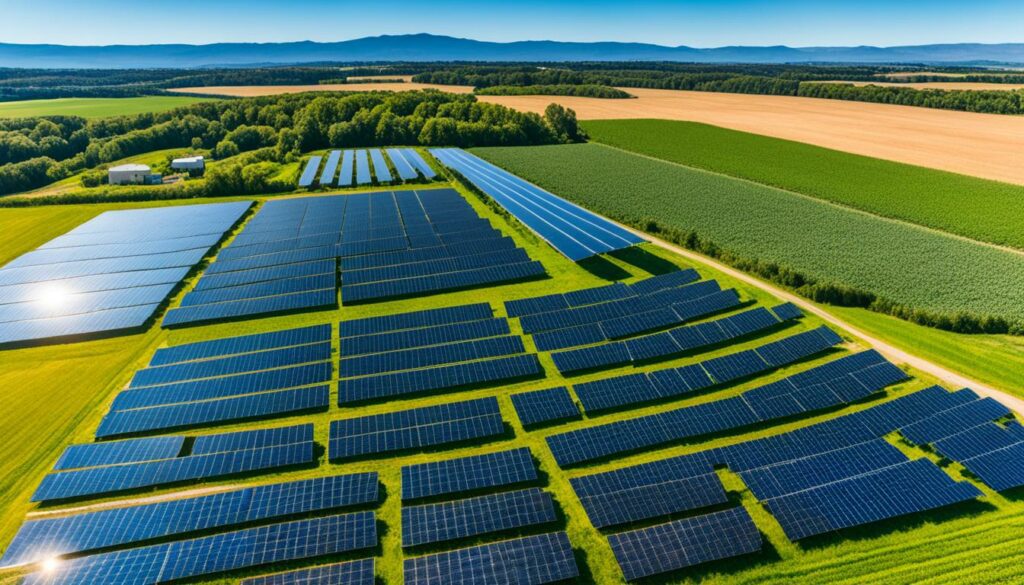
Wind power comes from wind turbines on farms. They turn wind into power, perfect for windy areas. Installing a wind system at home costs between $13,000 and $40,000. Wind power combines well with solar, ensuring continuous power.
Biofuels add another green level to farm energy. Biodiesel and ethanol are made from plants. Farmer Roger Rainville shows that biodiesel can cost less than $2 a gallon. Using more plant materials for fuel can make billions and reduce global warming. Biofuels cut the need for oil and boost farm earnings.
Using solar, wind, and biofuels makes farm energy strong and eco-friendly. It helps farms to be both sustainable and economically sound.
Solar power offers many benefits to farms. It helps farmers cut down on utility costs and gain energy independence. This leads to savings on powering machinery, lighting, and more. It also shows a commitment to the environment.
The federal investment tax credit is a huge plus for farmers. It allows them to deduct the full solar energy system cost from their taxes in the first year. This credit boosts the benefits of solar energy, making it more attractive for farmers.
Solar farms also help the environment. They improve water efficiency and support native plant growth. This is vital for the decreasing honey bee and other pollinator populations. Thus, they promote healthy ecosystems.
With net metering, farmers can earn credits from the energy they generate. This leads to savings on energy bills. Solar drying equipment outperforms traditional methods, protecting crops from damage.
Revenue and budget are positively affected by implementing solar power on farms. The ecological benefits are clear, with support for both local ecosystems and saving energy.
| Benefit | Details |
|---|---|
| Federal Investment Tax Credit (ITC) | Fully depreciates solar system costs within the first year, saving thousands on taxes. |
| Water Efficiency | Shade from solar panels helps native plants retain more water. |
| Energy Savings | Reduces utility costs by providing renewable energy for agricultural needs. |
| Net Metering Credits | Allows build-up of energy credits, leading to energy bill savings. |
| Improved Crop Drying | Solar-powered equipment offers faster, more even drying. |
| Pollinator Support | Solar installations help increase declining pollinator populations. |
So, solar power in farming not only saves money but also helps the planet. It’s key for farms aiming for self-sufficiency and using renewable energy.
Wind energy is great for our planet and our pockets. By using wind turbines, farms can make their own clean power. This cuts down their energy bills and makes them less reliant on outside sources.
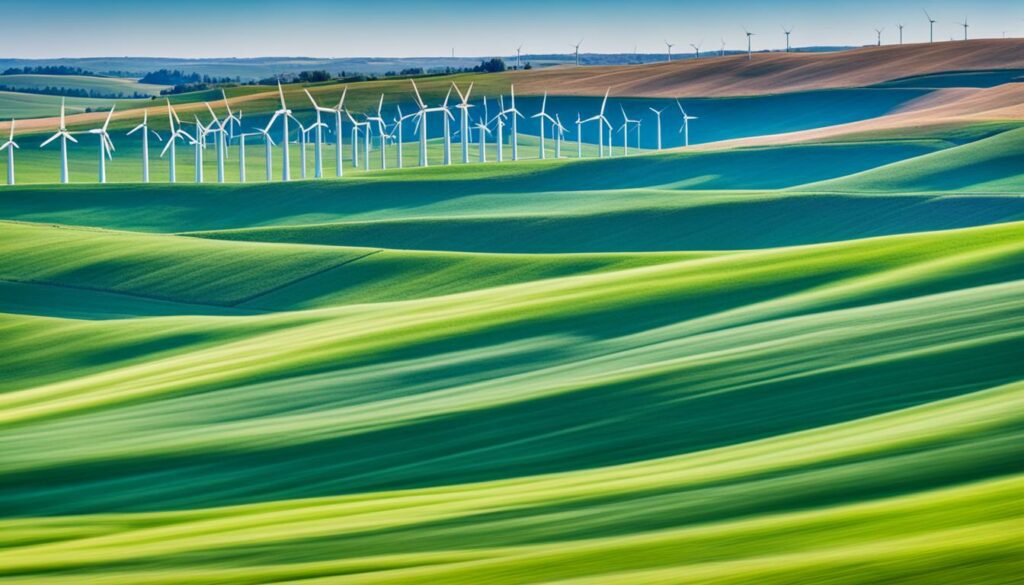
Wind turbines take the wind’s power to create electricity. This electricity can run the farm or be sold. If a farm is in a windy place, it can save a lot on energy. Some financial help is out there too. For instance, the Rural Energy for America Program (REAP) can cover half the costs. The Environmental Quality Incentives Program (EQIP) also offers aid for new energy projects.
Keeping power steady is a challenge, but important. Advanced storage tech helps by keeping extra electricity. This makes sure the farm has power even when the wind is calm. There are state help like rebates and grants for these storage solutions. Using these solutions lets farms make the most of wind energy, ensuring they have power and protecting the environment.
For deeper info on using renewables in farming, check out Harnessing Renewable Energy: A Sustainable Future for Farming.
Farmers now view alternative energy as key. They want to be less reliant on other sources while making more money. Biofuels offer a green option for energy, important for a sustainable future. Roger Rainville in Vermont shows that making biodiesel can actually save money. It costs him less than $2 for every gallon. This efficiency could change how farming works.
Wind, solar, and other renewables are being used a lot. These include biofuels made from plants like camelina and sunflowers. These plants grow fast again, which makes them a perfect choice. They also help the farm be more productive over time.
Biodiesel mainly comes from oilseeds, sugar plants, and special grasses. These are made into fuel that can power many diesel engines without changes. This makes it a smart option for green farming.
Then there’s ethanol, typically from corn or fruits. Dan West turns spare fruit into ethanol, making his farm more independent. Growing these special crops provides oil for use or sale. It even gives meal for feeding animals, creating a self-supporting farm system.
Besides, farms using solar power can run all year. This is possible with solar heating systems. Wind power is also big, growing faster than other energy types according to the U.S. Department of Energy. Wind farms on the land can make a lot of electricity. This makes farms even more sustainable.
Here is an overview of key data on biofuels in farming:
| Aspect | Data Point |
|---|---|
| Cost of Biodiesel Production (Roger Rainville) | Under $2 per gallon |
| Key Renewable Sources | Wind, Solar, Anaerobic Digestion, Biomass Energy |
| Renewable Oilseeds | Camelina, Canola, Sunflowers |
| Biodiesel Production Components | Vegetable Oil or Animal Fat, Alcohol, Catalyst |
| Common Biofuel Feedstocks | Oilseeds, Sugar Crops, Grasses (Switchgrass) |
Biofuels help farms use energy better. They make farming more profitable and better for the planet. By using biofuels, farms can ensure a greener future. This way, they meet their energy needs and take care of the environment.
Energy self-sufficient farms can find many ways to fund their move to renewable energy. They can get help from federal programs, state-level incentives, and tax credits. Let’s look at what’s on offer.
The Rural Energy for America Program (REAP) helps farms with money for renewable energy and efficiency upgrades. It provides grants and loan guarantees that can pay for up to 75% of a project. These benefits help farms in rural areas with fewer than 50,000 people.
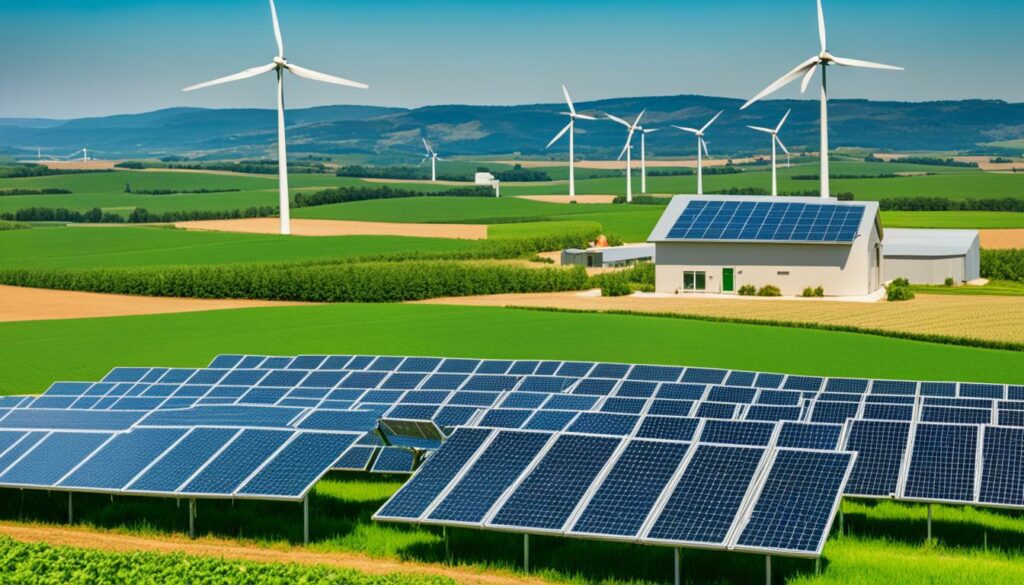
For projects starting in Fiscal Year 2024, REAP can give an 80% loan guarantee. Also, the loans can last up to 40 years. There’s a 1% fee to get the guarantee and a 0.25% yearly fee to keep the guarantee. Grants for renewable energy projects go from $2,500 to $1 million. Energy efficiency grants are from $1,500 to $500,000.
State incentives like Missouri’s Energize Program help with the cost of energy projects for farms. A loan programme also offers low-interest loans for energy-saving investments. Both these help make clean energy more affordable at a state level.
There’s also a no-interest loan programme for municipal utilities that help with storm costs. These incentives work with federal aid to give farmers more support.
Tax credits are another way to make going green affordable for farms. The Investment Tax Credit (ITC) is a good example. It cuts the cost of putting in solar and other clean systems. These credits help with the upfront cost and can lower your taxes for years to come.
| Funding Source | Type | Maximum Support | Eligibility |
|---|---|---|---|
| Rural Energy for America Program (REAP) | Loan & Grant | 75% of Project Cost | Rural Areas & Small Businesses |
| Energize Missouri Agriculture Program | Grant | Cost-Share | Energy Efficiency Projects |
| Energy Loan Program | Loan | Low-Interest | Energy-Saving Investments |
| Investment Tax Credit (ITC) | Tax Credit | Various | Renewable Energy Installations |
By understanding and using these funding options, farmers can move towards energy self-sufficiency. This leads to a more sustainable and profitable future for their farms.
Farmers are increasingly aiming for energy self-sufficiency. Looking at the experiences of Roger Rainville and Dan West sheds light on using renewable energy in farming. This shows the effective way of using renewable energy sources in farming activities.
Roger Rainville is a farmer who focuses on sustainable practices. He started making his own biodiesel. This involved using crops from his farm to create a clean fuel. It helped him use less of the expensive fuels from the market, aiming for better profits. His story shows how making biodiesel can lead to a farm becoming self-sufficient.
Dan West found a clever use for fruit waste by turning it into ethanol. With this, he could power his farming tools. This practice not only made his farm more self-sufficient in energy but also helped the environment. His example demonstrates the pros of adding ethanol production to farming practices.
Roger Rainville and Dan West’s stories suggest that making biodiesel and ethanol helps farms succeed on their own. These efforts are good for saving money, cutting down on pollution, and making farming more eco-friendly. This results in farms with lower greenhouse gas emissions and better use of resources.
Agrivoltaics is the smart blend of solar energy with farming. It brings huge benefits to both fields. By combining solar panels with crops, there’s a win-win situation. It boosts farming and energy in a special way.

Studies show agrivoltaics greatly boost crop yields. For example, in 2019, a study found that tomatoes and chiltepin peppers did twice as well under solar panels. The panels give just the right amount of shade. This makes the crops grow better.
*Agrivoltaics* can also cut down on water use, especially in dry places. Solar panels help by reducing how much water evaporates from the soil. This effect is big in areas with lots of sun, causing less water to be needed for crops.
Another plus is how agrivoltaics shield crops from bad weather. Solar panels act as barriers against rain, hail, or extreme heat. This helps keep crops safe, like in Texas’ huge heatwave. It shows how these systems are vital for protecting crops.
I’ve seen how agrivoltaics can even make animals like cows feel better. Solar panels give them shade, lowering their stress and raising their output. Also, planting certain types of plants under the panels improves nature’s well-being. This combo leads to a better, sustainable agricultural model.
Although agrivoltaics offer many pros, they need a big initial investment. They also need careful handling of issues like storing energy and supporting the right policies. Farmers have to consider these points to make the most of agrivoltaics in agriculture the right way.
Regenerative farming brings together many sustainable agricultural practices. It aims to make the land healthy again, increase plant and animal life, and help the environment. A key idea is to disturb the soil as little as possible.
This lessening of soil disturbance helps stop soil from washing away. It also encourages healthy life in the soil. This is important to keep the natural balance lasting.
Using different crops each year is a big part of regenerative farming. This does more than just feed the soil. It also makes farms stronger against bugs, without needing harmful chemicals.
Adding things like cover crops and mulch can make soil better. This way, farmers can use fewer chemicals and keep the land fertile. It’s all about working with nature, not against it.
Joining solar power with farming is a bright idea. It uses less water and earns extra money. Farmers can still use the land for crops or animals. This makes farming more sustainable and land more useful.
Using solar power in farming helps nature in many ways. It also saves water. The solar farming market is growing fast and it helps the farming economy. It’s good for the land and the people who farm it.
Regenerative farming also means planting trees on the farm. This helps wildlife and takes carbon out of the air. For example, a mix of trees with farm animals helps the land stay healthy.
These strategies are not just good for the farm. They also help the environment and the economy. By mixing things up on the farm, we can have a better future for both people and the land.
Modern agriculture relies on advanced sustainable farming tech. These advancements help in saving our planet and boost farm profits. They make farming more efficient and strong.
Precision agriculture changes how we farm by making it smarter. It uses GPS and remote sensing for better crop growing. This means less waste and more produce. The planet wins with farming that’s kinder to it.
Farming smart about water is very important. Automated systems watch the soil and weather. This helps use just the right amount of water, which is good for crops and saving water. These systems have saved farmer Roger Rainville in Vermont a lot of money.
Choosing farm machines that don’t harm the planet is smart. Things like solar and wind power are great for farms. Wind farms and solar panels are making farms greener and cheaper to run. Stateline Farm in Vermont is a good example, with its big plans for making biodiesel.
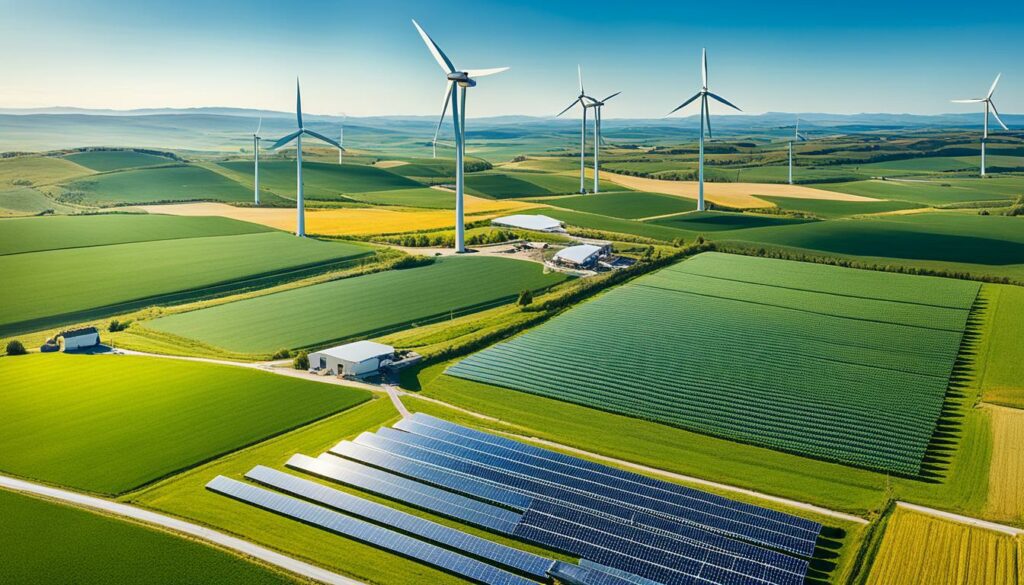
As we keep using and improving farm tech, we make our future better. Technologies like these help farmers deal with big challenges. They help farms make more money in ways that are kind to the Earth.
Off-grid farming means growing your food without relying much on outside help. It’s about becoming self-sufficient. But to make this work well, we have to tackle certain challenges first.
One big challenge is how to store energy in farming. Farms need power for water systems, taking care of animals, and more. Using batteries and systems that create energy from the sun and wind can help by making sure there’s always power.
Making sure farm energy is stored well needs careful planning. Farming uses solar panels and windmills to make renewable energy. But this energy needs to be kept for when it’s needed. Good storage with batteries helps keep the farm running, even on days with less sun or wind.
Managing water is crucial for off-grid farming. It’s important to use water wisely, especially in dry places. Systems that collect rainwater and pumps powered by the sun can help ensure there’s always enough water for plants and animals. Drip irrigation is another smart way to use water without wasting it.
Keeping systems running smoothly through regular checks and fast fixes is a must. This approach prevents big problems that can stop the farm. Having people who know how to do simple fixes is important. It lessens how long the farm might be not working.
By focusing on energy storage, water efficiency, and good equipment care, off-grid farms can be more sustainable and effective.
The environmental impact of self-sufficient farms is big and varied. By using biomass, wind power, and solar energy, farms lower their greenhouse gas emissions. If the U.S. used more biomass, we could cut as much carbon as removing 70 million cars from roads.
These energy sources help fight climate change and keep farms greener. Using solar heaters and wind turbines saves money and the planet. For example, certified solar heaters cut dairy farms’ heating costs by up to 85% a year.
Wind turbines can be a great help all year and even at night during growing seasons. They provide a steady energy source. These methods also help in protecting the environment. Small hydroelectric systems last 20-25 years, supporting the farm long-term.
Adding efficient systems like geothermal can pay off in 5 to 10 years. They cut the use of fossil fuels. This keeps the air cleaner and prevents damage to crops. The farm becomes more sustainable and strong.
Moving towards energy self-sufficiency mixes caring for the planet with smart money use. It makes agriculture tough and successful. Self-sufficient farms show how being innovative and green is key to farming today.
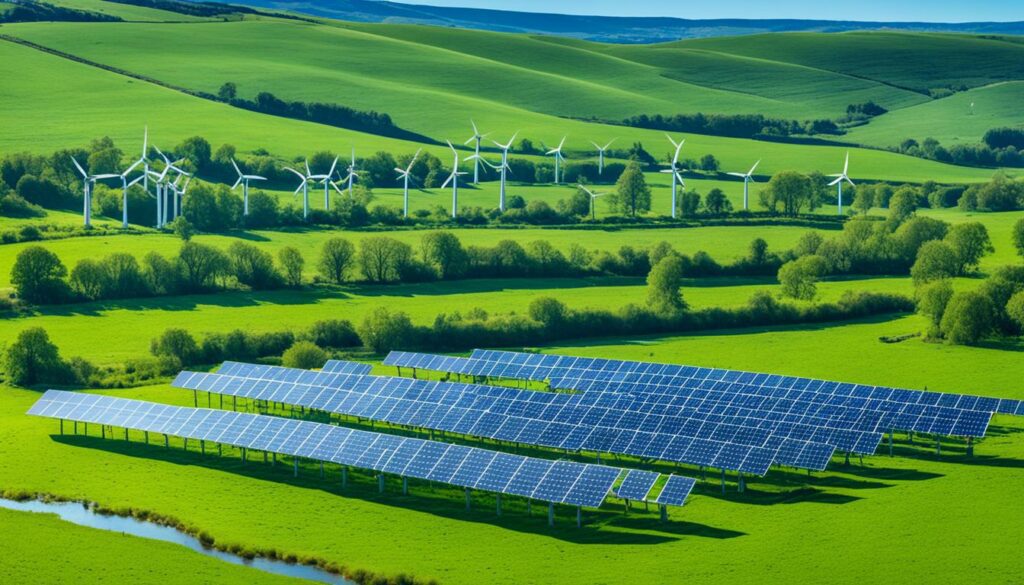
Sustainable farming helps the planet and the economy. It uses renewable energy like biodiesel, solar, and wind to cut costs. This boosts profits for farmers.
Sustainable farming cuts down on operational costs. For example, Roger Rainville in Vermont makes biodiesel for less than $2 a gallon. This reduces fuel costs and increases profits.
Growing biofuel crops, like camelina and sunflowers, brings in renewable energy. This saves money on fossil fuels, adding to the savings.
Sustainable farming opens new ways for farmers to make money. Many use wind and solar power. Solar panels heat water, power equipment, and lengthen growing time.
Wind turbines pump water and sell electricity, creating extra income. These methods make farming more profitable.
Choosing sustainable energy brings long-term financial safety. It helps withstand changes in fossil fuel prices. Farmers benefit from steady income with crops for biofuels and fruit for ethanol.
Dan West in Macon, Mo., shows how fuel self-sufficiency improves financial health. Sustainable practices build a strong farming future.
Sustainable farming offers many economic benefits. It lowers costs, creates new income, and ensures financial safety over time. These green technologies are key for a profitable and resilient future in agriculture.
In the past, farming was all about tradition. But now, we’re on the brink of something new. Today, sustainable farming is becoming a big part of agriculture. The FAO says 25% of people worldwide don’t have enough to eat. With the population heading to 10 billion by 2050, our farming needs to change.
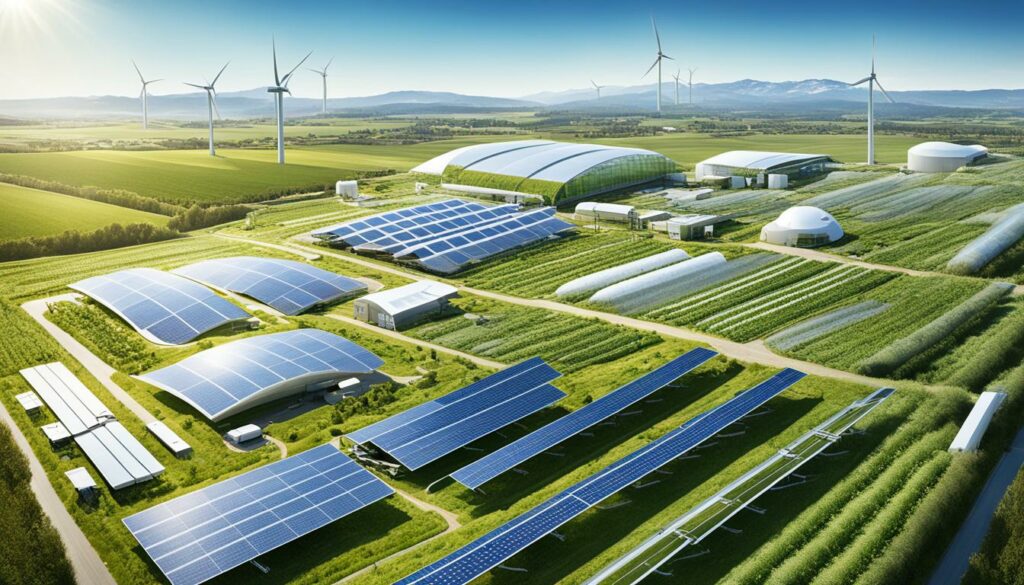
One big change is vertical farming. It can grow as much food in one acre as traditional farming does in 250. AppHarvest is a great example. They produce 30 times more tomatoes, using 90% less water. It’s a big step forward for sustainable farming.
There are also better ways to make biofuels and use resources. The Better Origin’s X1 machine, for example, cuts 130 tons of CO2 a year. This is good for reaching our climate goals.
But we’re not forgetting old ways of farming. Things like rewilding, keeping beef cattle on pasture, and regenerative farming help. These methods can boost how much food we make ourselves. They also help plant trees and restore nature on a large scale.
Looking forward, technology will do even more in farming. The Internet of Things (IoT) and artificial intelligence (AI) will change things. IoT is already used to watch things like soil moisture. AI studies the weather to help farmers use resources wisely.
Consumers are asking for eco-friendly and organic food. More than a third of the food made worldwide is wasted. This has made saving food and being efficient very important.
Now, there’s a big push for plant-based and lab-made proteins. This is because of health and the planet. People are starting to eat more crops like soybeans instead of traditional meats.
To wrap it up, farming is changing fast. To keep up, farms need to be flexible and green. Future farming trends offer a way for the farming world to flourish. They can be both competitive and good for the Earth.
Embracing energy self-sufficient farming is vital for our future. It makes farming both sustainable and profitable. High energy costs make life hard for farmers. So, they look to alternative energy. Vermont’s Roger Rainville shows how biodiesel can save money, costing less than $2 per gallon.
In the US, farmers are turning to renewable energy. They use wind and solar power, among others, to cut costs and increase profits. These new energy sources are not just cheaper. They also help the environment, offering benefits like oil for fuel and meal for animal feed.
The use of wind energy is growing fast worldwide. It’s great for making electricity and moving water on farms, using little space. Adding biofuels and anaerobic digestion helps cut ties with fossil fuels. It boosts profits, lowers emissions, and makes farming more efficient.
Looking ahead, more farmers will switch to renewable energy. They’ll use methods like agrivoltaics and regenerative practices. This will make farming not just profitable, but also eco-friendly and strong for the future.
Energy self-sufficient farms make their own energy. They use solar power, wind energy, and biofuels. This means they rely less on energy from outside.
Sustainable farming is very important. It protects our planet by using less fossil fuel. It helps keeps plants and animals varied and ecosystems healthy.
For farmers, it saves money and brings in a steady income. It also creates jobs and makes healthier food.
Solar panels help farms a lot. They cut down on electricity bills and make the farm more independent.
They also lower the farm’s carbon footprint. Plus, they can bring in a steady income with clean energy. Innovations can come from using these systems on the farm.
Wind energy is great for farms in windy areas. It provides a constant source of power.
Wind turbines are clean and reliable. They keep the farm going even when the wind isn’t blowing strongly.
Biofuels are green alternatives to petrol and diesel. They’re made from crops like corn and oilseeds. This means using less non-renewable energy.
Biofuels also give farmers fuel for their machinery and animal feed. This supports eco-friendly farming.
There are many ways to fund energy independent farms. The Rural Energy for America Program (REAP) is a federal option.
States have their own schemes too, like the Agriculture Energy Efficiency Rebate. Tax credits, such as the Investment Tax Credit (ITC), can also help pay for renewable energy systems.
Yes, for example, Roger Rainville makes his own biodiesel. This is cheaper than regular fuel, saving his farm money.
Dan West turns fruit waste into ethanol. He uses it to run his farm, showing how renewable energy can make a farm self-sufficient.
Agrivoltaics combines solar power with farming for better crops. It uses less water and protects from extreme weather.
This smart farming method makes better use of land. It’s a good way to farm sustainably.
Regenerative farming is all about improving the land without hurting it. It includes not tilling soil too much, growing many different crops, and adding natural fertilisers.
These methods work together to keep the environment and farm healthy. They help the farm last a long time.
Precise farming, automatic watering, and using eco-friendly machines are good for the environment. They save resources and make farming better.
This technology helps farmers do more with less, making farming both efficient and eco-friendly.
Off-grid farms might struggle with keeping enough power and managing water. Good battery storage and careful water use can solve these issues.
Regularly looking after the farm’s systems keeps everything working well. This is crucial for a farm that’s not connected to the grid.
Farms that produce their own energy help the planet by using less fossil fuel. This benefits nature, keeps the soil healthy, and encourages richer biodiversity.
They show how sustainable farming can make the Earth greener and healthier.
Sustainable farming can save money and earn extra through energy sales. It makes farming less risky because it doesn’t depend on changing fuel prices.
Green farming is not just good for the Earth, but also for the wallet.
In the future, farming will likely use more solar power and make better biofuels. It will also use resources more wisely.
These changes will make farming more modern, competitive, and green.